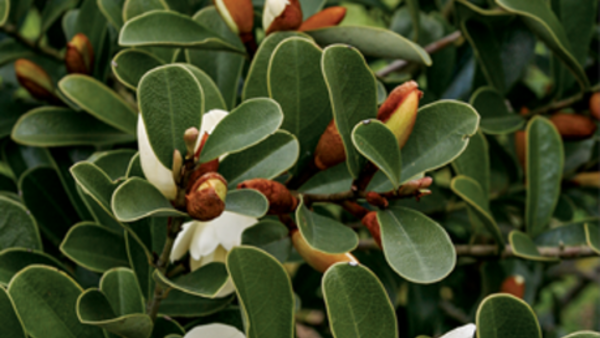1. ‘Blue Ice’ Arizona Cypress

Name: Cupressus arizonica var. glabra ‘Blue Ice’
USDA Hardiness Zones: 6 to 9
Size: 25 to 30 feet tall and 8 to 12 feet wide
Conditions: Full sun to partial shade; neutral to alkaline, well-drained soil
Whether planted en masse, as a screen or windbreak, or singularly to celebrate its unique color and form, ‘Blue Ice’ Arizona cypress evokes an element of garden surprise. This drought-tolerant conifer’s powder blue foliage complements any garden color scheme and provides a cooling illusion on even the hottest summer days. While a well-drained location is a must, poor soils are no challenge for this heat-loving conical tree. Quirky cones and a signature exfoliating bark in stripes of copper, brass, and gold add another layer of interest as it matures.
2. ‘Pioneer Sentry’ Incense Cedar

Name: Calocedrus decurrens ‘Pioneer Sentry’
Zones: 5 to 8
Size: 35 to 40 feet tall and 4 feet wide
Conditions: Full sun to partial shade; well-drained soil
‘Pioneer Sentry’ is the exclamation point of incense cedars. Its tight, columnar form puts it in a sorely limited group of fastigiate trees suitable for the climate and soil of the Southern Plains. How fitting that this upright cultivar with rugged cinnamon-colored bark and a heat- and drought-tolerant disposition was found in a Portland, Oregon, pioneer cemetery. Infrequently planted outside its genus’s native range, ‘Pioneer Sentry’ maintains its dark green foliage year-round. Unique lanternlike cones borne on the tips of scalelike foliage provide additional interest.
3. Canaert Red Cedar
Name: Juniperus virginiana ‘Canaertii’
Zones: 3 to 9
Size: 20 to 30 feet tall and 12 to 15 feet wide
Conditions: Full sun to partial shade; moist, well-drained soil
This was a must-have conifer in the Southern Plains decades ago but, for some reason, fell out of favor. That’s a shame because Canaert red cedar’s compact form, year-round bright green foliage, and abundant berry production make the plant a great choice for screening or as a specimen ornamental tree. With age, this conifer will break its juvenile form, exposing an irregular branching habit. While moist, fertile soils are optimal, this red cedar is drought tolerant and able to withstand long periods of extreme summer heat. In mast years of berry set, this red cedar will take on an overall blue-gray cast that will diminish to green as hungry winter birds devour the fruit.
4. ‘Saratoga Gold’ Yaupon Holly
Name: Ilex vomitoria ‘Saratoga Gold’
Zones: 7 to 10
Size: 16 to 20 feet tall and 12 to 15 feet wide
Conditions: Full sun to partial shade; moist, well-drained soil
Why settle for red holly berries when you can have yellow ones, instead? Yaupon holly is a large broadleaf shrub than can be kept as a small tree. It’s so adaptable, in fact, that some gardeners shape it—without much effort—into an espalier, a topiary, a bonsai, or a hedge. ‘Saratoga Gold’ Yaupon holly makes a beautiful ornamental tree with light gray bark (that never becomes corky); glossy, needleless leaves; and abundant, pearl-size yellow berries. This holly tolerates various types of soils and moisture extremes.
Bill Seaman is an arborist with Arborilogical Services in Wylie, Texas, and serves as a trustee for the Texas Historic Tree Coalition.
Photos: (1), Doreen Wynja; (2), Thomas Alamy/gapphotos.com; (3), millettephotomedia.com; (4), courtesy of Mercer Arboretum & Botanic Gardens



















Comments
Log in or create an account to post a comment.
Sign up Log in